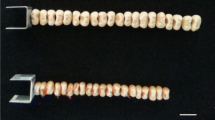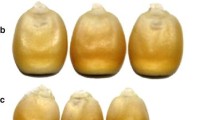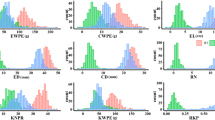Abstract
Heterosis has been extensively applied for many traits during maize breeding, but there has been relatively little attention paid to the heterosis for kernel size. In this study, we evaluated a population of 301 recombinant inbred lines derived from a cross between 08-641 and YE478, as well as 298 hybrids from an immortalized F2 (IF2) population to detect quantitative trait loci (QTLs) for six kernel-related traits and the mid-parent heterosis (MPH) for these traits. A total of 100 QTLs, six pairs of loci with epistatic interactions, and five significant QTL × environment interactions were identified in both mapping populations. Seven QTLs accounted for over 10% of the phenotypic variation. Only four QTLs affected both the trait means and the MPH, suggesting the genetic mechanisms for kernel-related traits and the heterosis for kernel size are not completely independent. Moreover, more than half of the QTLs for each trait in the IF2 population exhibited dominance, implying that dominance is more important than other genetic effects for the heterosis for kernel-related traits. Additionally, 20 QTL clusters comprising 46 QTLs were detected across ten chromosomes. Specific chromosomal regions (bins 2.03, 6.04–6.05, and 9.01–9.02) exhibited pleiotropy and congruency across diverse heterotic patterns in previous studies. These results may provide additional insights into the genetic basis for the MPH for kernel-related traits.




Similar content being viewed by others
Data availability
All supporting data and materials are available from the corresponding authors upon request.
References
Bates D, Mächler M, Bolker B, Walker S (2015) Fitting linear mixed-effects models using lme4. J Stat Softw 67:1–48
Bruce AB (1910) The Mendelian theory of heredity and the augmentation of vigor. Science 32:627–628
Chen DH, Ronald PC (1999) A rapid DNA minipreparation method suitable for AFLP and other PCR applications. Plant Mol Biol Rep 17:53–57
Chen J, Zhang L, Liu S, Li Z, Huang R, Li Y, Cheng H, Li X, Zhou B, Wu S, Chen W, Wu J, Ding J (2016a) The genetic basis of natural variation in kernel size and related traits using a four-way cross population in maize. PLoS One 11:e0153428
Chen L, Li YX, Li C, Wu X, Qin W, Li X, Jiao F, Zhang X, Zhang D, Shi Y, Song Y, Li Y, Wang T (2016b) Fine-mapping of qGW4.05, a major QTL for kernel weight and size in maize. BMC Plant Biol 16:81
Chen L, An Y, Li Y, Li C, Shi Y, Song Y, Zhang D, Wang T, Li Y (2017) Candidate loci for yield-related traits in maize revealed by a combination of meta QTL analysis and regional association mapping. Front Plant Sci 8:2190
Cockerham CC, Zeng ZB (1996) Design III with marker loci. Genetics 143:1437–1456
Davenport CB (1908) Degeneration, albinism and inbreeding. Science 28:454–455
Dickinson DB, Preiss J (1969) Presence of ADP-glucose pyrophosphorylase in shrunken-2 and brittle-2 mutants of maize endosperm. Plant Physiol 44:1058–1062
Doerge RW, Churchill GA (1996) Permutation tests for multiple loci affecting a quantitative character. Genetics 142:285–294
Duvick DN (1999) Heterosis: feeding people and protecting natural resources. In: Coors JG, Pandey S (eds) Proceedings of the international symposium on the genetics and exploitation of heterosis in crops, CIMMYT, Mexico city, 17–22 Aug 1997. ASA, CSSA, and SSSA, Madison, pp 19–29
East EM (1908) Inbreeding in corn. Conn Agric Exp Stn Rep 1907:419–428
Falconer DS, Mackay TFC (1996) Introduction to quantitative genetics, 4th edn. Longman, Essex
Flint-Garcia SA, Buckler ES, Tiffin P, Ersoz E, Springer NM (2009) Heterosis is prevalent for multiple traits in diverse maize germplasm. PLoS One 4:e7433
Frascaroli E, Canè MA, Landi P, Pea G, Gianfranceschi L, Villa M, Morgante M, Pè ME (2007) Classical genetic and quantitative trait loci analyses of heterosis in a maize hybrid between two elite inbred lines. Genetics 176:625–644
Garcia AAF, Wang SC, Melchinger AE, Zeng ZB (2008) Quantitative trait loci mapping and the genetic basis of heterosis in maize and rice. Genetics 180:1707–1724
Guo T, Yang N, Tong H, Pan Q, Yang X, Tang J, Wang J, Li J, Yan J (2014) Genetic basis of grain yield heterosis in an “immortalized F2” maize population. Theor Appl Genet 127:2149
Hallauer AR, Mirando FJB (1988) Quantitative genetics in maize breeding, 2nd edn. Iowa State University, Ames
Hua JP, Xing YZ, Xu CG, Sun XL, Yu SB, Zhang QF (2002) Genetic dissection of an elite rice hybrid revealed that heterozygotes are not always advantageous for performance. Genetics 162:1885–1895
Hua JP, Xing YZ, Wei WR, Xu CG, Sun XL, Yu SB, Zhang QF (2003) Single-locus heterotic effects and dominance by dominance interactions can adequately explain the genetic basis of heterosis in an elite rice hybrid. Proc Natl Acad Sci USA 100:2574–2579
Knapp S, Stroup W, Ross W (1985) Exact confidence intervals for heritability on a progeny mean basis. Crop Sci 25:192–194
Kosambi DD (1943) The estimation of map distances from recombination values. Ann Eugen 12:172–175
Lan T, He K, Chang L, Cui T, Zhao Z, Xue J, Liu J (2018) QTL mapping and genetic analysis for maize kernel size and weight in multi-environments. Euphytica 214:119
Larièpe A, Mangin B, Jasson S, Combes V, Dumas F, Jamin P, Lariagon C, Jolivot D, Madur D, Fiévet J, Gallais A, Dubreuil P, Charcosset A, Moreau L (2012) The genetic basis of heterosis: multiparental quantitative trait loci mapping reveals contrasted levels of apparent overdominance among traits of agronomical interest in maize (Zea mays L.). Genetics 190:795–835
Li H, Ye G, Wang J (2007) A modified algorithm for the improvement of composite interval mapping. Genetics 175:361–374
Li H, Ribaut JM, Li Z, Wang J (2008) Inclusive composite interval mapping (ICIM) for digenic epistasis of quantitative traits in biparental populations. Theor Appl Genet 116:243–260
Li Y, Wang Y, Shi Y, Song Y, Wand T, Li Y (2009) Correlation analysis and QTL mapping for traits of kernel structure and yield components in maize. Sci Agric Sin 42:408–418
Li Q, Li L, Yang X, Warburton ML, Bai G, Dai J, Li J, Yan J (2010a) Relationship, evolutionary fate and function of two maize co-orthologs of rice GW2 associated with kernel size and weight. BMC Plant Biol 10:143
Li Q, Yang X, Bai G, Warburton ML, Mahuku G, Gore M, Dai J, Li J, Yan J (2010b) Cloning and characterization of a putative GS3 ortholog involved in maize kernel development. Theor Appl Genet 120:753
Li X, Li Y, Chen L, Wu X, Qin W, Song Y, Zhang D, Wang T, Li Y, Shi Y (2016) Fine mapping of qKW7, a major QTL for kernel weight and kernel width in maize, confirmed by the combined analytic approaches of linkage and association analysis. Euphytica 210:221
Li H, Yang Q, Gao L, Zhang M, Ni Z, Zhang Y (2017) Identification of heterosis-associated stable QTLs for ear-weight-related traits in an elite maize hybrid zhengdan 958 by design III. Front Plant Sci 8:561
Liu Y, Wang L, Sun C, Zhang Z, Zheng Y, Qiu F (2014) Genetic analysis and major QTL detection for maize kernel size and weight in multi-environments. Theor Appl Genet 127:1019–1037
Liu Y, Hou X, Xiao Q, Yi Q, Bian S, Hu Y, Liu H, Zhang J, Hao X, Cheng W, Li Y, Huang Y (2016) Genetic analysis in maize foundation parents with mapping population and testcross population: Ye478 carried more favorable alleles and using QTL information could improve foundation parents. Front Plant Sci 7:1417
Liu J, Huang J, Guo H, Lan L, Wang H, Xu Y, Yang X, Li W, Tong H, Xiao Y, Pan Q, Qiao F, Raihan MS, Liu H, Zhang X, Yang N, Wang X, Deng M, Jin M, Zhao L, Luo X, Zhou Y, Li X, Zhan W, Liu N, Wang H, Chen G, Li Q, Yan J (2017) The conserved and unique genetic architecture of kernel size and weight in maize and rice. Plant Physiol 175:774–785
Lu H, Romero-Severson J, Bernardo R (2003) Genetic basis of heterosis explored by simple sequence repeat markers in a random-mated maize population. Theor Appl Genet 107:494–502
Mathias L (2012) MapDisto: fast and efficient computation of genetic linkage maps. Mol Breed 30:1231–1235
Melchinger AE, Utz HF, Piepho HP, Zeng ZB, Schön CC (2007) The role of epistasis in the manifestation of heterosis: a systems-oriented approach. Genetics 177:1815–1825
Meng L, Li H, Zhang L, Wang J (2015) QTL IciMapping: integrated software for genetic linkage map construction and quantitative trait locus mapping in biparental populations. Crop J 3:269–283
Pan D, Nelson OE (1984) A debranching enzyme deficiency in endosperms of the Sugary-7 mutants of maize. Plant Physiol 74:324–328
Powers L (1944) An expansion of Jones’s theory for the explanation of heterosis. Am Nat 78:275–280
Qin WW, Li YX, Wu X, Li X, Chen L, Shi YS, Song YCH, Zhang DF, Wang TY, Li Y (2016) Fine mapping of qKL1.07, a major QTL for kernel length in maize. Mol Breed 36:1–9
R Development Core Team (2010) R: a language and environment for statistical computing. http://www.r-project.org. Accessed 1 Mar 2019
Rice WR (1989) Analyzing tables of statistical tests. Evolution 43:223–225
SAC (2009) National standards of the P. R. C. Standardization Administration of the People Republic of China, Standards Press of China, Beijing, P. R. China. https://www.chinesestandard.net/PDF/English.aspx/GB1353–2009. Accessed 1 Mar 2019
Samayoa LF, Malvar RA, Butrón A (2017) QTL for maize midparent heterosis in the heterotic pattern american Dent × European flint under corn borer pressure. Front Plant Sci 8:573
Schmidt RJ, Burr FA, Burr B (1987) Transposon tagging and molecular analysis of the maize regulatory locus opaque-2. Science 238:960–963
Schmidt RJ, Ketudat M, Aukerman MJ, Hoschek G (1992) Opaque-2 is a transcriptional activator that recognizes a specific target site in 22 kD zein genes. Plant Cell 4:689–700
Schön CC, Dhillon BS, Utz HF, Melchinger AE (2010) High congruency of QTL positions for heterosis of grain yield in three crosses of maize. Theor Appl Genet 120:321–332
Shull GH (1908) The composition of a field of maize. Am Breed Assoc Rep 4:296–301
Stuber CW, Lincoln SE, Wolff DW, Helentjaris T, Lander ES (1992) Identification of genetic factors contributing to heterosis in a hybrid from two elite maize inbred lines using molecular markers. Genetics 132:823–839
Tang J, Yan J, Ma X, Teng W, Wu W, Dai J, Dhillon BS, Melchinger AE, Li J (2010) Dissection of the genetic basis of heterosis in an elite maize hybrid by QTL mapping in an immortalized F2 population. Thero Appl Genet 120:333–340
Wang D, Zhu J, Li Z, Paterson A (1999) Mapping QTLs with epistatic effects and QTL × environment interactions by mixed linear model approaches. Theor Appl Genet 99:1255–1264
Wang H, Zhang X, Yang H, Liu X, Li H, Yuan L, Li W, Fu Z, Tang J, Kang D (2016) Identification of heterotic loci associated with grain yield and its components using two CSSL test populations in maize. Sci Rep 6:38205
Wang Y, Zhang X, Shi X, Sun C, Jin J, Tian R, Wei X, Xie H, Guo Z, Tang J (2018) Heterotic loci identified for maize kernel traits in two chromosome segment substitution line test populations. Sci Rep 8:11101
Wei X, Lu X, Zhang Z, Xu M, Mao K, Li W, Wei F, Sun P, Tang J (2016) Genetic analysis of heterosis for maize grain yield and its components in a set of SSSL testcross populations. Euphytica 210:181
Williams W (1959) Heterosis and the genetics of complex characters. Nature 184:527–530
Yang J, Zhu J, Williams RW (2007) Mapping the genetic architecture of complex traits in experimental populations. Bioinformatics 23:1527–1736
Yang J, Hu C, Hu H, Yu R, Xia Z, Ye X, Zhu J (2008) QTLNetwork: mapping and visualizing genetic architecture of complex traits in experimental populations. Bioinformatics 24:721–723
Yang C, Zhang L, Jia A, Rong T (2016) Identification of QTL for maize grain yield and kernel-related traits. J Genet 95:239–247
Zhan J, Wang F, Xing W, Liu J, Fan Z, Tao Y (2018) Fine mapping and candidate gene prediction of a major QTL for kernel number per ear in maize. Mol Breed 38:27
Zhang Z, Liu Z, Hu Y, Li W, Fu Z, Ding D, Li H, Qiao M, Tang J (2014) QTL Analysis of kernel-related traits in maize using an immortalized F2 population. PLoS One 9:e89645
Zhang Z, Wu X, Shi C, Wang R, Li S, Wang Z, Liu Z, Xue Y, Tang G, Tang J (2016) Genetic dissection of the maize kernel development process via conditional QTL mapping for three developing kernel-related traits in an immortalized F2 population. Mol Genet Genomics 291:437–454
Zhang C, Zhou Z, Yong H, Zhang X, Hao Z, Zhang F, Li M, Zhang D, Li X, Wang Z, Weng J (2017) Analysis of the genetic architecture of maize ear and grain morphological traits by combined linkage and association mapping. Theor Appl Genet 130:1011–1029
Zhou Q, Dong Y, Shi Q, Zhang L, Chen H, Hu C, Li Y (2017) Verification and fine mapping of qGW1.05, a major QTL for grain weight in maize (Zea mays L.). Mol Genet Genomics 292:871
Zhu X, Shao X, Pei Y, Guo X, Li J, Song X, Zhao M (2018) Genetic diversity and genome-wide association study of major ear quantitative traits using high-density SNPs in maize. Front Plant Sci 9:966
Acknowledgements
We thank all students for participating in the fieldwork. We thank Liwen Bianji, Edanz Editing China (www.liwenbianji.cn/ac) for editing the English text of a draft of this manuscript.
Funding
This study was funded by the Applied Basic Research Programs of Science and Technology Department of Sichuan Province (2016JY0065).
Author information
Authors and Affiliations
Corresponding author
Ethics declarations
Conflict of interest
The authors declare that they have no conflict of interest.
Research involving human participants and/or animals
This article does not contain any studies with human participants or animals performed by any of the authors.
Additional information
Communicated by Stefan Hohmann.
Publisher's Note
Springer Nature remains neutral with regard to jurisdictional claims in published maps and institutional affiliations.
Electronic supplementary material
Below is the link to the electronic supplementary material.
Rights and permissions
About this article
Cite this article
Liu, Y., Yi, Q., Hou, X. et al. Identification of quantitative trait loci for kernel-related traits and the heterosis for these traits in maize (Zea mays L.). Mol Genet Genomics 295, 121–133 (2020). https://doi.org/10.1007/s00438-019-01608-1
Received:
Accepted:
Published:
Issue Date:
DOI: https://doi.org/10.1007/s00438-019-01608-1




